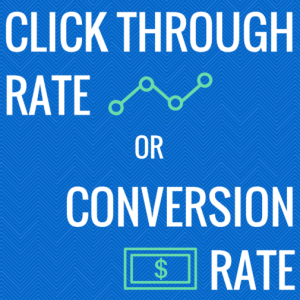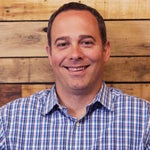Posted on 3/11/2015 in Digital Marketing
By Dean Dorazio

CTR & Conversion Rates
Managing a paid search account can be complicated, especially when measuring success. There are a number of best practices to follow that will steer you in the right direction, but every Account Manager has their own theories as to which metrics are important to measure (of course these will vary based on the goals of the account). One set of performance metrics that are consistently useful across all accounts are the click-through rate and the conversion rate. These two have an ongoing battle over which one is more important, so we’re going to take a closer look at which is more important; the click-through rate or conversion rate.
What is a Click Through Rate?
The Click Through Rate (CTR) is simply the percentage of visitors that click on your ad. To find it, you divide the number of impressions your ad gets by the number of clicks on your ad. An average click-through rate is 2%, but each industry has its own standards. A low click-through rate can mean your keywords are not targeted enough, meaning the ad copy is irrelevant to the searcher, or that your ad copy is just not standing out among the competition. A low CTR can affect your ad placement since a lower CTR leads to a lower quality score. To raise the click-through rate, make sure your keywords are specific and that the ad copy is informative but enticing to the searcher. That being said, a high CTR does not necessarily mean your ads are relevant. If you have a high CTR but a low conversion rate, you are most likely driving the wrong traffic to your page, meaning once the visitor arrives, they do not convert.

What is a Conversion Rate?
Google defines the Conversion Rate as “the average number of conversions per ad click”. They state that “conversion rates are calculated by simply taking the number of conversions and dividing that by the number of total ad clicks that can be tracked to a conversion during the same time period. For example, if you had 50 conversions from 1,000 clicks, your conversion rate would be 5%, since 50 ÷ 1,000 = 5%”. The average conversion rate is 1%, but like the CTR, each industry has its own average. A low conversion rate can mean that your product or service is not clearly defined or that your call to action was not clear enough to warrant a purchase. It could also be that your form fill was too long or too broad. To increase your conversion rate, try A/B testing your landing pages and optimizing them with keywords targeted toward your ideal visitors. Adding a customer testimonial or a special offer can also help.

So What’s More Important: CTR or Conversion Rate?
Although the click-through rate is important, the ultimate goal of the ad is a sale or a lead, making the conversion rate the more important success metric. If you are driving traffic to the pages but you are not converting, the traffic was irrelevant. What’s the point in advertising if you aren’t going to convert searchers?
If you need help driving the right visitors to your website to help increase conversions, contact Wakefly today.
Struggling to get more visitors to your site?
Get Your Free AuditRelated Articles

How Do I Optimize My Website for AI?
Why do you need to optimize your website for AI?AI-powered search engines like Google’s AI Overview, Perplexity, and tools such as Microsoft's [...]

Outdated or Outstanding? How to Tell If Your Website Needs a Refresh
Your website is the digital face of your business. It serves as a first impression, a marketing tool, and a resource for potential customers. [...]

Preparing a Website Redesign Budget for 2025: A Step-by-Step Guide
As we approach 2025, businesses are recognizing the necessity of a fresh, user-friendly website to stay competitive in a rapidly evolving digital [...]

